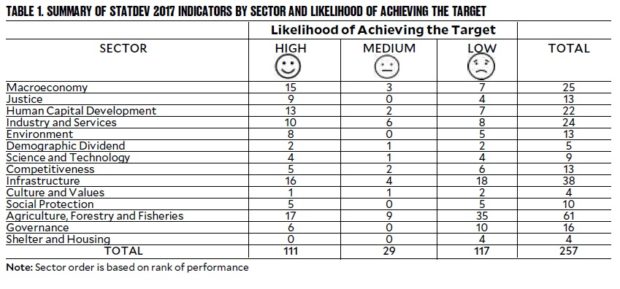What is the real score with respect to the Duterte administration’s performance so far? His supporters give him excellent marks, his opponents give him failing marks. So what is the Reader to conclude?
My answer: Reader, go to the Philippine Statistics Authority (PSA) website and click on StatDev, which is short for the Statistical Indicators on Philippine Development. It will give you all the information you need to make your own decision, which you can be sure is based on evidence and not partisan hype. That’s what counts.
The StatDev “aims to monitor the likelihood of achieving the economic and social development goals set forth in the PDP.” What is the PDP? It is the Philippine Development Plan, which lays out the objectives of each administration coinciding with the term of the President. Precisely to find out how the country is performing in its struggle for development, one should look at the StatDev’s congruence with the current PDP.
To make things easier for the public, the PDP has been accompanied by a Results Matrix (PDP-RM), starting from the P-Noy administration. The PDP-RM lists all the targets and outcomes desired by the government for the plan period, together with the government agency responsible for the achievement of the targets or goals.
Where does the PSA gets its data about the PDP’s targets? From the government agencies themselves, as well as from what is collected by the PSA itself—National Income, Labor Force, Family Income and Expenditures, etc.
Please, Reader, visit the PSA website.
So, Reader, the StatDev tells us not only where the country is with regard to the targets (indicators), but also who is sleeping on the job, as it were. Pity that this information has never been used by either the past or present President to determine which Cabinet member or agency head should get the axe.
The PSA also very conveniently provides us a Summary of StatDev 2017 Indicators by Sector and Likelihood of Achieving the Target, which is reproduced below.
What does this tell us? First, it tells us that, as of 2017, the government has a high likelihood of achieving only 111 of the 257 targets it had set out to achieve in the PDP; 117 of the targets have a low likelihood, and for the rest, or 29 targets, it’s a tossup. The methodology of determining the likelihoods is given. In other words, the country’s performance has been, at best, mediocre.
This conclusion, however, must be qualified, because all the targets are given the same importance. For example, the target of increasing the ratio of Gross National Saving to GDP is given the same importance as the target of reducing remittance costs as a proportion of the amount remitted. Therefore, one must look more closely into the targets themselves.
Second, it tells us that Macroeconomy, Justice, and Human Capital Development are the best performers out of the 14 sectors listed in the PDP, as far as the number of targets likely to be achieved are concerned. The worst performers are Agriculture, Forestry and Fisheries (AFF), Governance, and Shelter and Housing.
Eyebrows raised? Stick with me, Reader. We will continue our discussion in the succeeding column.
solita_monsod@yahoo.com


